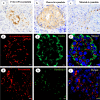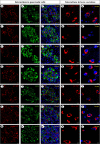Mixed pathologies in pancreatic β cells from subjects with neurodegenerative diseases and their interaction with prion protein
- PMID: 33832546
- PMCID: PMC8028740
- DOI: 10.1186/s40478-021-01171-0
Mixed pathologies in pancreatic β cells from subjects with neurodegenerative diseases and their interaction with prion protein
Abstract
Protein misfolding diseases refer to a variety of disorders that develop as a consequence of the misfolding of proteins in various organs. The etiologies of Parkinson's and Alzheimer's disease remain unclear, but it seems that type two diabetes and other prediabetic states could contribute to the appearance of the sporadic forms of these diseases. In addition to amylin deposition, other amyloidogenic proteins implicated in the pathophysiology of neurodegenerative diseases could have important roles in the pathogenesis of this disease. As we have previously demonstrated the presence of α-synuclein deposits in the pancreas of patients with synucleinopathies, as well as tau and Aβ deposits in the pancreatic tissue of Alzheimer's disease patients, we studied the immunoreactivity of amylin, tau and α-synuclein in the pancreas of 138 subjects with neurodegenerative diseases or type two diabetes and assessed whether the pancreatic β-cells of these subjects present cooccurrence of misfolded proteins. Furthermore, we also assessed the pancreatic expression of prion protein (PrP) in these subjects and its interaction, both in the pancreas and brain, with α-synuclein, tau, Aβ and amylin. Our study shows, for the first time, that along with amylin, pancreatic α-synuclein, Aβ, PrP and tau may contribute together to the complex pathophysiology of type two diabetes and in the appearance of insulin resistance in Alzheimer's and Parkinson's disease. Furthermore, we show that the same mixed pathologies that are observed in the brains of patients with neurodegenerative diseases are also present outside the nervous system. Finally, we provide the first histological evidence of an interaction between PrP and Aβ, α-synuclein, amylin or tau in the pancreas and locus coeruleus. These findings will shed more light on the common pathological pathways shared by neurodegenerative diseases and type two diabetes, benefiting the exploration of common therapeutic strategies to prevent or treat these devastating amyloid diseases.
Keywords: Alpha-synuclein; Alzheimer’s disease; Parkinson’s disease; PrP; Tau; Type two diabetes mellitus.
Conflict of interest statement
IAV received remuneration from Merck Sharp & Dohme (MDS) for activities unrelated to the work submitted. MRL received remuneration from TEVA, Zambon, AbbVie and Bial for activities unrelated to the work submitted. The other authors have no conflict of interest to declare.
Figures





References
-
- Alafuzoff I, Ince PG, Arzberger T, Al-Sarraj S, Bell J, Bodi I, Bogdanovic N, Bugiani O, Ferrer I, Gelpi E, Gentleman S, Giaccone G, Ironside JW, Kavantzas N, King A, Korkolopoulou P, Kovács GG, Meyronet D, Monoranu C, Parchi P, Parkkinen L, Patsouris E, Roggendorf W, Rozemuller A, Stadelmann-Nessler C, Streichenberger N, Thal DR, Kretzschmar H. Staging/typing of Lewy body related α-synuclein pathology: a study of the BrainNet Europe Consortium. Acta Neuropathol. 2009;117:635–652. doi: 10.1007/s00401-009-0523-2. - DOI - PubMed
-
- Balducci C, Beeg M, Stravalaci M, Bastone A, Sclip A, Biasini E, Tapella L, Colombo L, Manzoni C, Borsello T, Chiesa R, Gobbi M, Salmona M, Forloni G. Synthetic amyloid-β oligomers impair long-term memory independently of cellular prion protein. Proc Natl Acad Sci. 2010;107:2295–2300. doi: 10.1073/pnas.0911829107. - DOI - PMC - PubMed
Publication types
MeSH terms
Substances
LinkOut - more resources
Full Text Sources
Other Literature Sources
Medical
Research Materials

